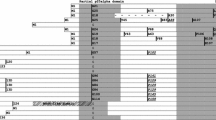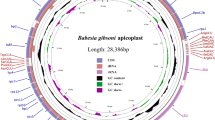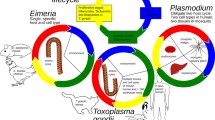Abstract
Phosphatidylinositol 4-phosphate 5-kinase (PIP5K) may play an important role in host-cell invasion by the Eimeria species, protozoan parasites which can cause severe intestinal disease in livestock. Here, we report the structural organization of the PIP5K gene in Eimeria maxima (Weybridge strain). Two E. maxima BAC clones carrying the E. maxima PIP5K (EmPIP5K) coding sequences were selected for shotgun sequencing, yielding a 9.1-kb genomic segment. The EmPIP5K coding region was initially identified using in silico gene-prediction approaches and subsequently confirmed by mapping rapid amplification of cDNA ends and RT-PCR-generated cDNA sequence to its genomic segment. The putative EmPIP5K gene was located at position 710-8036 nt on the complimentary strand and comprised of 23 exons. Alignment of the 1147 amino acid sequence with previously annotated PIP5K proteins from other Apicomplexa species detected three conserved motifs encompassing the kinase core domain, which has been shown by previous protein deletion studies to be necessary for PIP5K protein function. Phylogenetic analysis provided further evidence that the putative EmPIP5K protein is orthologous to that of other Apicomplexa. Subsequent comparative gene structure characterization revealed events of intron loss/gain throughout the evolution of the apicomplexan PIP5K gene. Further scrutiny of the genomic structure revealed a possible trend towards “intron gain” between two of the motif regions. Our findings offer preliminary insights into the structural variations that have occurred during the evolution of the PIP5K locus and may aid in understanding the functional role of this gene in the cellular biology of apicomplexan parasites.




Similar content being viewed by others
References
Abascal F, Zardoya R, Posada D (2005) ProtTest: selection of best-fit models of protein evolution. Bioinformatics 21(9):2104–2105
Altschul SF, Madden TL, Schäffer AA, Zhang J, Zhang Z, Miller W, Lipman DJ (1997) Gapped BLAST and PSI-BLAST: a new generation of protein database search programs. Nucleic Acids Res 25:3389–3402
Apweiler R, Attwood TK, Bairoch A, Bateman A, Birney E, Biswas M, Bucher P, Cerutti L, Corpet F, Croning MDR (2001) InterPro database, an integrated documentation resource for protein families, domains and functional sites. Nucleic Acids Res 29:37–40
Basu MK, Rogozin IB, Deusch O, Dagan T, Martin W, Koonin EV (2008) Evolutionary dynamics of introns in plastid-derived genes in plants: saturation nearly reached but slow intron gain continues. Mol Biol Evol 25:111–119
Baum J, Gilberger TW, Frischknecht F, Meissner M (2008) Host-cell invasion by malaria parasites: insights from Plasmodium and Toxoplasma. Trends Parasitol 24:557–563
Berman HM, Henrick K, Nakamura H (2003) Announcing the worldwide Protein Data Bank. Nat Struct Biol 10:980
Blake DP, Smith AL, Shirley MW (2003) Amplified fragment length polymorphism analyses of Eimeria spp.: an improved process for genetic studies of recombinant parasites. Parasitol Res 90:473–475
Burge C, Karlin S (1997) Prediction of complete gene structures in human genomic DNA. J Mol Biol 268:78–94
Burgoyne RD, O'Callaghan DW, Hasdemir B, Haynes LP, Tepikin AV (2004) Neuronal Ca2+-sensor proteins: multitalented regulators of neuronal function. Trends Neurosci 27:203–209
Caldas LA, de Souza W, Attias M (2007) Calcium ionophore-induced egress of Toxoplasma gondii shortly after host cell invasion. Vet Parasitol 147:210–220
Carmel L, Wolf YI, Rogozin IB, Koonin EV (2007) Three distinct modes of intron dynamics in the evolution of Eukaryotes. Genome Res 17:1034–1044
Carreno RA, Matrin DS, Barta JR (1999) Cryptosporidium is more closely related to the gregarines than to coccidia as shown by phylogenetic analysis of apicomplexan parasites inferred using small-subunit ribosomal RNA gene sequences. Parasitol Res 85:899–904
Castresana J (2000) Selection of conserved blocks from multiple alignments for their use in phylogenetic analysis. Mol Biol Evol 17:540–552
Dobrowolski JM, Sibley LD (1996) Toxoplasma invasion of mammalian cells is powered by the actin cytoskeleton of the parasite. Cell 84:933–939
Dobrowolski JM, Carruthers VB, Sibley LD (1997) Participation of myosin in gliding motility and host cell invasion by Toxoplasma gondii. Mol Microbiol 26:163–173
Dubremetz JF, Garcia-Reguet N, Conseil V, Fourmaux MN (1998) Apical organelles and host-cell invasion by Apicomplexa. Int J Parasitol 28:1007–1013
Dunn PPJ, Bumstead JM, Tomley FM (1996) Sequence, expression and localization of calmodulin-domain protein kinases in Eimeria tenella and Eimeria maxima. Parasitol 113:439–448
Dunn PP, Billington K, Bumstead JM, Tomley FM (1995) Isolation and sequences of cDNA clones for cytosolic and organellar hsp70 species in Eimeria spp. Mol Biochem Parasitol 70:211–215
Escalante A, Ayala F (1995) Evolutionary origin of Plasmodium and other Apicomplexa based on rRNA genes. Proc Natl Acad Sci USA 92:5793–5797
Gonzalez V, Combe A, David V, Malmquist NA, Delorme V, Leroy C, Blazquez S, Ménard R, Tardieux I (2009) Host cell entry by apicomplexa parasites requires actin polymerization in the host cell. Cell Host & Microbe 5:259–272
Guindon S, Gascuel O (2003) A simple, fast, and accurate algorithm to estimate large phylogenies by maximum likelihood. Syst Biol 52:696–704
Ishihara H, Shibasaki Y, Kizuki N, Wada T, Yazaki Y, Asano T, Oka Y (1998) Type I phosphatidylinositol-4-phosphate 5-kinases: cloning of the third isoform and deletion/substitution analysis of members of this novel lipid kinase family. J Biol Chem 273:8741–8748
Jean L, Perry P, Dunn P, Bumstead J, Billington K, Ryan R, Tomley F (2001) Genomic organization and developmentally regulated expression of an apicomplexan aspartyl proteinase. Gene 262:129–136
Jeffares DC, Mourier T, Penny D (2006) The biology of intron gain and loss. Trends Genet 22:16–22
Katinka MD, Duprat S, Cornillot E, Metenier G, Thomarat F, Prensier G, Barbe V, Peyretaillade E, Brottier P, Wincker P, Delbac F, Alaoui HE, Peyret P, Saurin W, Gouy M, Weissenbach J, Vivares CP (2001) Genome sequence and gene compaction of the eukaryote parasite Encephalitozoon cuniculi. Nature 414:450–453
Kelley LA, Sternberg MJE (2009) Protein structure prediction on the web: a case study using the Phyre server. Nat Protocol 4:363–371
Kunz J, Wilson MP, Kisseleva M, Hurley JH, Majerus PW, Anderson RA (2000) The activation loop of phosphatidylinositol phosphate kinases determines signaling specificity. Mol Cell 5:1–11
Kuo CH, Kissinger JC (2008) Consistent and contrasting properties of lineage-specific genes in the apicomplexan parasites Plasmodium and Theileria. BMC Evol Biol. doi:10.1186/1471-2148-8-108
Kuo CH, Wares JP, Kissinger JC (2008) The Apicomplexan whole-genome phylogeny: an analysis of incongruence among gene trees. Mol Biol Evol 25:2689–2698
Lang-Unnasch N, Reith ME, Munholland J, Barta JR (1998) Plastids are widespread and ancient in parasites of the phylum Apicomplexa. Int J Parasitol 28:1743–1754
Larkin MA, Blackshields G, Brown NP, Chenna R, McGettigan PA, McWilliam H, Valentin F, Wallace IM, Wilm A, Lopez R, Thompson JD, Gibson TJ, Higgins DG (2007) ClustalW and ClustalX version 2. Bioinformatics 23:2947–2948
Leander BS, Clopton RE, Keeling PJ (2003) Phylogeny of gregarines (Apicomplexa) as inferred from small-subunit rDNA and β-tubulin. Int J Syst Evol Microbiol 53:345–354
Leber W, Skippen A, Fivelman QL, Bowyer PW, Cockcroft S, Baker DA (2009) A unique phosphatidylinositol 4-phosphate 5-kinase is activated by ADP-ribosylation factor in Plasmodium falciparum. Int J Parasitol 39:645–653
Le Hir H, Nott A, Moore MJ (2003) How introns influence and enhance eukaryotic gene expression. Trends Biochem Sci 28:215–220
Li L, Stoeckert CJ, Roos DS (2003) OrthoMCL: identification of ortholog groups for eukaryotic genomes. Genome Res 13:2178–2189
Lien YY, Sheu SC, Liu HJ, Chen SC, Tsai MY, Luo SC, Wu KC, Liu SS, Su HY (2007) Cloning and nucleotide sequencing of the second internal transcribed spacer of ribosomal DNA for three species of Eimeria from chickens in Taiwan. Vet J 173:184–189
Ling KH, Loo SS, Rosli R, Shamsudin MN, Mohamed R, Wan KL (2007a) In silico identification and characterization of a putative phosphatidylinositol 4-phosphate 5-kinase (PIP5K) gene in Eimeria tenella. In Silico Biol 7:115–121
Ling KH, Rajandream MA, Rivailler P, Ivens A, Yap SJ, Madeira AMBN, Mungall K, Billington K, Yee WY, Bankier AT, Carroll F, Durham AM, Peters N, Loo SS, Mat-Isa MN, Novaes J, Quail M, Rosli R, Mariana NS, Sobreira TJP, Tivey A, Wai SF, White S, Wu X, Kerhornou A, Blake D, Mohamed R, Shirley M, Gruber A, Berriman M, Tomley F, Dear PH and Wan KL (2007b) Sequencing and analysis of chromosome 1 of Eimeria tenella reveals a unique segmental organization. Genome Research 17:311–319
Loijens JC, Anderson RA (1996) Type I phosphatidylinositol-4-phosphate-5 kinases are distinct members of this novel lipid kinase family. J Biol Chem 271:32937–32943
Lovett JL, Sibley LD (2003) Intracellular calcium stores in Toxoplasma gondii govern invasion of host cells. J Cell Sci 116:3009–3016
Marchler-Bauer A, Anderson JB, Derbyshire MK, DeWeese-Scott C, Gonzales NR, Gwadz M, Hao L, He S, Hurwitz DI, Jackson JD, Ke Z, Krylov D, Lanczycki C, Liebert CA, Liu C, Lu F, Marchler GH, Mullokandov M, Song JS, Thanki N, Yamashita RA, Yin JJ, Zhang D, Bryant SH (2007) CDD: a conserved domain database for interactive domain family analysis. Nucleic Acids Res 35:D237–D240
Nene V, Bishop R, Morzaria S, Gardner MJ, Sugimoto C, ole-MoiYoi OK, Fraser CM, Irvin A (2000) Theileria parva genomics reveals an atypical apicomplexan genome. Int J Parasitol 30:465–474
Pasamontes L, Hug D, Humbelin M, Weber G (1993) Sequence of a major Eimeria maxima antigen homologous to the Eimeria tenella microneme protein Etp100. Mol Biochem Parasitol 57:171–174
Periz J, Ryan R, Blake DP, Tomley FM (2009) Eimeria tenella microneme protein EtMIC4: capture of the full-length transcribed sequence and comparison with other microneme proteins. Parasitol Res 104:717–721
Plattner F, Yarovinsky F, Romero S, Didry D, Carlier MF, Sher A, Soldati-Favre D (2008) Toxoplasma profilin is essential for host cell invasion and TLR11-dependent induction of an interleukin-12 response. Cell Host & Microbe 3:77–87
Riordan CE, Langreth SG, Sanchez LB, Kayser O, Keithly JS (1999) Preliminary evidence for a mitochondrion in Cryptosporidium parvum: phylogenetic and therapeutic implications. J Eukaryot Microbiol 46:52S–55S
Roy SW, Hartl DL (2006) Very little intron loss/gain in Plasmodium: Intron loss/gain mutation rates and intron number. Genome Res 16:750–756
Roy SW, Penny D (2006) Large-scale intron conservation and order-of-magnitude variation in intron loss/gain rates in apicomplexan evolution. Genome Res 16:1270–1275
Roy SW, Penny D (2007) Widespread intron loss suggests retrotransposon activity in ancient apicomplexans. Mol Biol Evol 14:1926–1933
Roy SW, Irimia M (2008) Mystery of intron gain: new data and new models. Trends Genet 25:67–73
Rutherford K, Parkhill J, Crook J, Horsnell T, Rice P, Rajandream MA, Barrell B (2000) Artemis: sequence visualization and annotation. Bioinformatics 16:944–945
Sakharkar KR, Dhar PK, Chow VT (2004) Genome reduction in prokaryotic obligatory intracellular parasites of humans: a comparative analysis. Int J Syst Evol Microbiol 54:1937–1941
Sambrook J, Russell DW (2001) Molecular cloning: a laboratory manual, 3rd edn. Cold Spring Harbor Laboratory Press, New York
Seeber F (1997) Consensus sequence of translational initiation sites from Toxoplasma gondii genes. Parasitol Res 83:309–311
Shirley MW, Blake DP, White SE, Sheriff R, Smith AL (2004a) Integrating genetics and genomics to identify new leads for the control of Eimeria spp. Parasitol 128:S33–S42
Shirley MW, Ivens A, Gruber A, Madeira AM, Wan K-L, Dear PH, Tomley FM (2004b) The Eimeria genome projects: a sequence of events. Trends Parasitol 20:199–201
Shirley MW, Smith AL, Tomley FM (2005) The biology of avian Eimeria with an emphasis on their control by vaccination. Adv Parasitol 60:285–330
Shirley MW, Smith AL, Blake DP (2007) Challenges in the successful control of the avian coccidia. Vaccine 25:5540–5547
Soldati D, Foth BJ, Cowman AF (2004) Molecular and functional aspects of parasite invasion. Trends Parasitol 20:567–572
Stanke M, Diekhans M, Baertsch R, Haussler D (2008) Using native and syntenically mapped cDNA alignments to improve de novo gene finding. Bioinformatics 24:637–644
Su YC, Fei ACY, Tsai FM (2003) Differential diagnosis of five avian Eimeria species by polymerase chain reaction using primers derived from the internal transcribed spacer (ITS-1) sequence. Vet Parasitol 117:221–227
Tolias KF, Rameh LE, Ishihara H, Shibasaki Y, Chen J, Prestwich GD, Cantley LC, Carpenter CL (1998) Type I phosphatidylinositol-4-phosphate 5 kinases synthesizes the novel lipids phosphatidylinositol 3, 5-bisphosphate and phosphatidylinositol 5-phosphate. J Biol Chem 273:18040–18046
Tomley FM, Clarke LE, Kawazoe U, Dijkema R, Kok JJ (1991) Sequence of the gene encoding an immunodominant microneme protein of Eimeria tenella. Mol Biochem Parasitol 49:277–288
Vinogradov AE (2001) Intron length and codon usage. J Mol Evol 52:2–5
Yeh RF, Lim LP, Burge CB (2001) Computational inference of homologous gene structures in the human genome. Genome Res 11:803–816
Zhang MQ (2002) Computational prediction of eukaryotic protein-coding genes. Nat Rev Genet 3:698–709
Zhu G, Keithly JS, Philippe H (2000a) What is the phylogenetic position of Cryptosporidium? Int J Syst Evol Microbiol 50:1673–1681
Zhu G, Marchewka MJ, Keithly JS (2000b) Cryptosporidium parvum appears to lack a plastid genome. Microbiol 146:315–321
Acknowledgements
This project was supported by the Genomics and Molecular Biology Initiatives Programme of the Malaysia Genome Institute, Ministry of Science, Technology and Innovation Malaysia (Project No. 07-05-16-MGI-GMB10) and the Biotechnology and Biological Sciences Research Council, UK (BBSRC Grant BBE01089X1). The authors would like to acknowledge Dr Michael Quail for construction of the E. maxima BAC library and Karen Billington for construction of the SMART cDNA library. The authors would like to thank the Sanger Institute and the E. tenella Genome Consortium (http://www.sanger.ac.uk/Projects/E_tenella/consortium.shtml) for generation of the E. tenella sequencing data supported by the BBSRC and the Wellcome Trust.
Author information
Authors and Affiliations
Corresponding author
Rights and permissions
About this article
Cite this article
Goh, MY., Pan, MZ., Blake, D.P. et al. Eimeria maxima phosphatidylinositol 4-phosphate 5-kinase: locus sequencing, characterization, and cross-phylum comparison. Parasitol Res 108, 611–620 (2011). https://doi.org/10.1007/s00436-010-2104-7
Received:
Accepted:
Published:
Issue Date:
DOI: https://doi.org/10.1007/s00436-010-2104-7




